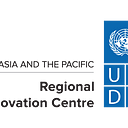
Navigating the New Abnormal in the Asia Pacific- from Signals, Scans, to the Spaces in Between
By the Heads of Exploration, UNDP Asia Pacific Region
Although several posts have been written on possible ‘new normals’, ‘the next normal’ and tracking signals of disruption — from policy to citizen driven (COVID19 triggered) responses, it is uncertainty that remains the common denominator.
As we move through this abnormal (pandemic induced) moment, the Heads of Exploration in the UNDP Asia Pacific have been meeting regularly to scan the horizon for signals of change. In this post we share observations and spaces to watch, a nod to that which is mainstreaming, plus a few provocations that could carry interesting implications. We also wanted to share a little about our (imperfect) research approach, process, and why taking stock of the ‘multidimensional now’, with the intent to better understand the framework for shaping a post-pandemic space matters.

Observation and inference
New spaces to watch range from nascent geo-political positioning narratives, to the ways in which social safety nets are being digitalised, to education delivery. In our co-created Kumu Map, you will find a high-level synthesis of our session notes. We took elements from our internal meetings (our 8th one since kicking off in February) and mapped them across a radar plot with the following buckets: policy shifts, public sector capabilities, innovations, paradigm shifts, and cascading effects.
Patterns that rose to the top, and are tagged in terms of trend direction (i.e. weak to strengthening) include the following: #digitalisation (e-gov and e-commerce), #informal market innovations, #distance learning and education, #localisation, #migrationflows, and #environment. If you double click on the themes we identified you will see supporting text, links to articles and a few anecdotes- especially relevant to capture when some information is still bubbling up in social media, face to face or in a local language.

Provocations and sticky inquiry
Each time we meet we typically shift a little of our attention to what strikes us in terms of relevance or outliers. These conversations usually invite more questions to surface. Here are a few of the contradictions and provocations that we notice:
New normal vs. old — competing narratives and bias
While futurists may be having a field day painting possible scenarios, we can observe several different frames offered depending upon the sector, geo-political leaning or philosophical underpinnings of the ‘story teller’. Are we in the midst of a climate disaster or opportunity? As headlines suggest grand opportunities for a green recovery, we also note, for example, that China has since surpassed pre-COVID-19 emission levels, with regulation that has been rolled back in the past few months. Yet, as pointed out by Purnima Bajracharya of the Nepal A Lab, the extended lockdown has shown improved air quality particularly in Urban centers like Kathmandu.
At the same time, we find it important to consider who is being asked in all of the ubiquitous polling data that surfaces in the noisy news cycles. For example, a recent study in Britain noted that only 9% of Britons want to return to pre-COVID19 norms, yet when Pagna Ukthaun, from the Cambodia A Lab team, asked informal workers in his local neighborhood what they want to see happen, the desire is business as usual. The urgent need for income coupled with an ‘‘if you die, you die” philosophy is part of this backstory. In a similar vein, Phan Lan, of the Vietnam A Lab shared the sentiment that “basically for us (Vietnamese) it’s the ‘old normal’ … the perception is that it’s (COVID19) over. It’s almost 5 weeks now without a new case, there is not much on the news anymore about it, so ‘back to normal.’”
Digital dividend vs. digital divide
The technology and social justice and development intersection is full of complexity. If you look (and double click on the notes) parked on our Kumu radar, you will see the powerful and dynamic role that accelerated experiments are having in terms of the digitalisation of safety nets, commerce, education and public services. In fact, the Regional Innovation Centre has been running a podcast series dedicated to capturing the raw learnings of public sector’s leveraging of technology. Yet all of this comes quickly, and often with an invisible cost that must be confronted at a later stage.
As Benjamin Ong, of the Malaysia A Lab notes, there are exacerbating inequalities and challenges to social cohesion with policies: “For instance, though digital platforms are being used to continue teaching, digitalisation of education is still challenging. Schools play complex, essential roles in society. Many of the non-curricular functions of schools (e.g., friends, extra-curricular activities, sharing the burden of childcare and social security) cannot be easily replicated via online teaching platforms.”
Also, as shared by Beenisch Tahir, of the Pakistan A Lab:“The digital divide is a major challenge with only 20% of the total population using smartphones and 20–30% of the population has access to the internet. Social welfare schemes involving digital payments could not be accessed by the majority of the population because of the digital divide. Only the elite and those who have access to the internet gain benefits from these schemes.”
Yet, on the other hand, to the point of a ‘dividend’ to reap: Krishnan Raghavan, of the India A Lab team shares, the “digital divide is impacting an already weak informal economy. Yet digital technologies also offer potential opportunities to establish linkages of MSMEs with large corporations and to be an integral part of their supply chains. Besides, digital technologies also have the potential to transform the informal sector and make it more resilient to external shocks and supply chain disruptions due to possible future outbreaks.” Another dividend is the shift towards digital marketing and e-commerce to meet the daily consumer demand through online shopping which has increased by 300–400% due to the lockdown in Nepal. As noted by our Nepal colleague: “While e-commerce is creating additional opportunities, and potentially mitigates the impact of the prolonged lockdown, it also requires a more robust regulatory framework to protect the customer. And hence Government of Nepal is initiating new regulation for the e-commerce sector.”
Politicization of the response and exacerbation of inequalities
Several of us noted that in our region, on a positive note, many countries are seeing a decline in the number of new cases, and now several governments are working towards the post-COVID-19 phase by relaxing lockdowns to stimulate the economy and get ‘back to normal’. Yet, it is also a time of emergency politics and maneuvering- where decision making is done to win votes or protect the status quo. On a tangential note, there is then the exacerbation of inequalities- fault lines are visibly emergent (globally, yet certainly in Asia) in terms of gender, race, economic, migrant and educational disparities.
FYI — our (imperfect) process notes
Over the past several months our team has met bi-monthly to exchange- we usually start with digital mapping on MURAL in advance of our calls. When we first started we followed the STEEP frame- mapping weak signals along social, technological, economic, environment and political frames. Over time we have evolved depending on what seems ripe for a deep dive. For our last session, for example, we also took a closer look at the policy and responses emerging in regards to MSMEs, Supply Chains, Migration, Jobs/Employment, Healthcare, Digitalization/e-gov transitions across the region. The objective is to download intel, among the many Accelerator Labs in the Asia Pacific Region, in real time, yet with the purpose of providing information that may support strategic decision making for post pandemic policy and programmes. Building on Policy Lab’s futures thinking framework, most of our sessions are dedicated with Trends, Signals and Drivers, with the intent to help our teams cast future scenarios in tandem with anticipated UNDP interventions.


How to Build Back Better?
Policymakers, Intermediaries and the Citizen Sector are accountable to work together. The COVID-19 outbreak is changing each and every aspect of our lives- and in the past few months we are noting the ‘evidence’ that rises to the surface, or “reactions” to the pandemic. As Ash Buchanan, rightly points out in his post How holding space transforms our ability to respond:
“In this moment of great uncertainty, many of our leaders and space holders are facing complexities they have never had to face before. This includes parents holding space at home, organisers of community and interest groups, and leaders holding space at a school, organisation or national level. So, in the face of great uncertainty, how can we as leaders and space holders, host this complexity and activate our ability to respond.”

In terms of the Asia-Pacific region, the point of view from which we write, the impact of COVID-19 remains profound. Our region is ‘home’ to more than two-thirds of the global population, a diverse region with the most advanced economies, to least developed countries, from being the manufacturing hub for the world, as well as largest consumers of goods and services. However, it also shows how quick action, steadfast policies and innovation, displayed by several Asian countries, can effectively deal with this unprecedented outbreak and uncertainty. In these times it’s about how we ‘hold space’, for the spaces in between and across the multidimensional now, in the midst of complexity, that will allow for us to build back better. The effect of COVID-19 on the economies in the region is a multi-pronged and presents unique challenges as well as opportunities for countries to revive economic growth and to pursue progress towards achieving the Sustainable Development Goals.
This post was co-written by the Heads of Exploration of the UNDP Asia Pacific Region- you can follow us on twitter: Courtney Savie Lawrence (Regional Innovation Center Asia Pacific), Krishnan Raghavan (India Accelerator Lab), Benjamin Ong (Malaysia Accelerator Lab), Francisco De Araujo (Timor Leste Accelerator Lab), Beenisch Tahir (Pakistan Accelerator Lab), Victor Ladele (Accelerator Lab Pacific), Purnima Bajracharya (Nepal Accelerator Lab), Maria Irina Velasco (Philippines Accelerator Lab), Pagna Ukthaun (Cambodia Accelerator Lab), Phan Lan(Vietnam Accelerator Lab), Maniphet Phengsavatdy (Laos Accelerator Lab)
What are Accelerator Labs doing around the world? You can catch up with the latest here- acceleratorlabs.undp.org








